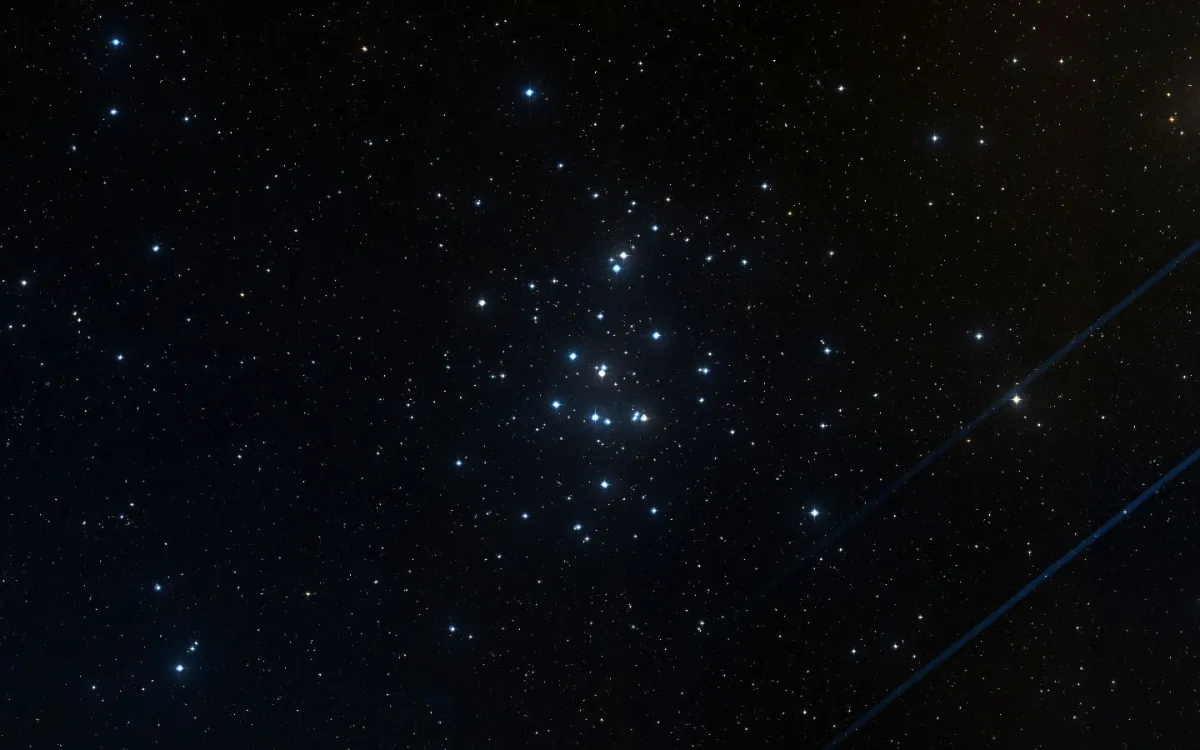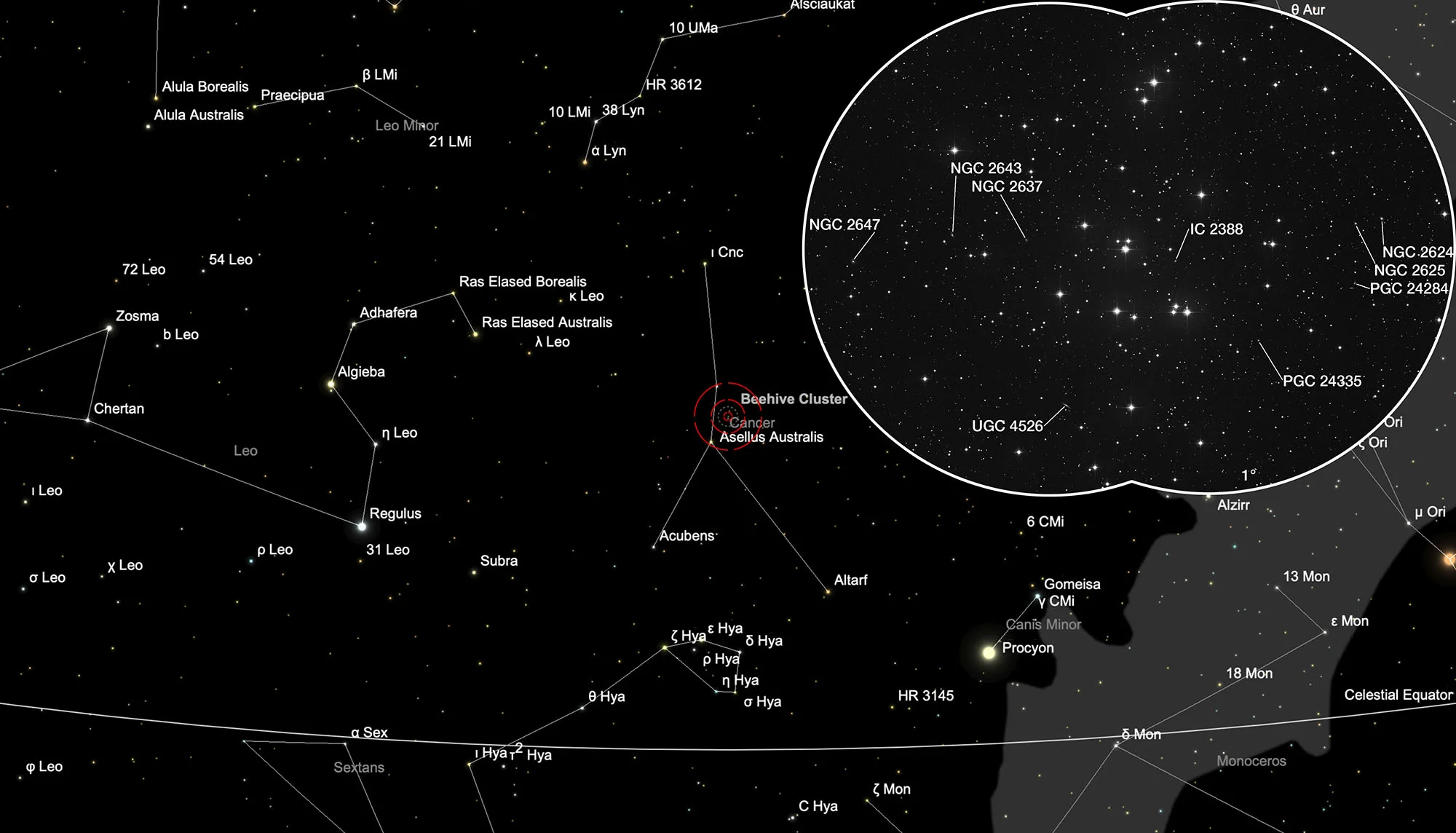Praesepe, Beehive Cluster (Messier 44)

History
The open star cluster Messier 44 in the constellation Cancer is also called «Beehive Cluster» or «Praesaepe». Because it can easily be seen as a misty spot with the naked eye even under modest observation conditions, it has been known for many centuries. For example, Hipparchus (130 B.C.) called it a «little cloud». He included M 44 as a «cloudy star» in his star catalog. [Jones] It was not until 1610 that Galileo Galilei discovered with the telescope he had built that it was a collection of stars. [4]
❝ Am Firmament funkeln die Sterne.
Die winzigen Lichtchen, ich sehe sie gerne.
Gern seh' ich auch die Nebel dort oben
und Dunkelwolken zu Netzen verwoben,
ferne Milchstrassen, 'nahe' Planeten,
schnuppende Sterne und hübsche Kometen.
Nur eines darf mir gestohlen werden:
planetarische Nebel hier unten auf Erden. ❞
Physical Properties
Baade estimates the age of M 44 to be around 400 million years, other data go up to 660 million years. This star cluster is significantly older than the Pleiades (M 45). Its mean density of 1.5 stars per cubic parsec is very low, in the centre it reaches 13.8 stars per cubic parsec (Wallenquist).
Trümpler gives the diameter of the star cluster as almost 6 degrees, including all faint stars; Its classification of the cluster is I, 2, r. The distance from M 44 is currently given as about 180 parsec.
| Designation | NGC 2632 |
| Type | OCL (II2m) |
| Right Ascension (J2000.0) | 08h 40m 24.0s |
| Declination (J2000.0) | +19° 40' 12" |
| Diameter | 70 arcmin |
| Photographic (blue) magnitude | 3.5 mag |
| Visual magnitude | 3.1 mag |
| Metric Distance | 0.187 kpc |
| Dreyer Description | Paesepe Cancri |
| Identification, Remarks | h 517; GC 1681; M 44; OCL 507; Praesepe, Beehive cluster |
Galaxies behind M 44
Behind the open star cluster are a number of galaxies, most of which appear to us to be small and faint. For this reason they are only listed here for the sake of form.
| Name | RA | Dec | Type | bMag | vMag | B-V | SB | Dim | PA | z | D(z) | Dreyer Description | Identification, Remarks |
|---|---|---|---|---|---|---|---|---|---|---|---|---|---|
| NGC 2624 | 08 38 09.6 | +19 43 34 | Gx (S) | 14.9 | 14.1 | 0.8 | 12.6 | 0.6 × 0.5 | 15 | 0.013903 | 58.73 | eF | GC 5429; UGC 4506; MCG 3-22-19; CGCG 89-55; ARAK 172; NPM1G +19.0183; in M44 |
| NGC 2625 | 08 38 23.1 | +19 42 58 | Gx (E1) | 14.9 | 13.9 | 1.0 | 13.0 | 0.7 × 0.6 | 45 | 0.015090 | 63.74 | eF, vS | GC 5430; MK 625; CGCG 89-57; in M 44 |
| NGC 2637 | 08 41 13.4 | +19 41 25 | Gx (S?) | 15.5 | 14.7 | 0.8 | 13.0 | 0.6 × 0.4 | 30 | 0.032374 | 136.7 | eeF, vS | GC 5431; CGCG 89-65 |
| NGC 2643 | 08 42 09.0 | +19 31 20 | NF | eF neb * | GC 5432; IC 2390 ? | ||||||||
| NGC 2647 | 08 42 43.0 | +19 39 04 | Gx (C) | 15.3 | 14.3 | 1.0 | 13.2 | 0.8 × 0.5 | 18 | 0.055001 | 232.3 | Neb * | GC 5433; CGCG 89-68; NPM1G +19.0188; in M 44 |
| IC 2388 | 08 39 56.5 | +19 38 41 | Gx (S) | 15.5 | 14.7 | 0.8 | 11.8 | 0.4 × 0.2 | 160 | 0.032734 | 138.2 | eF, S, dif, ? FN, * 10 n 90" | CGCG 89-63; in M 44 |
Where do you find the swarm of bees?
The constellation Cancer is located between Leo and Gemini. If you lengthen the distance between the two bright twin stars Castor and Pollux by about three times to the southeast, you can see M44 with the naked eye. not far from the 4 mag bright star δ Cancri (Asellus Australis). The close-up is used to identify the small, faint galaxies.
Visual Observation
Naked Eye, Binocular, RFT: With its size of a good one and a half degrees (three times the full moon diameter), the star cluster itself is best seen in binoculars and small telescopes with a large field of view. Then a dense, impressive cloud of bright stars appears.
400mm Aperture: But M 44 also has a lot to offer for the observer with a large telescope aperture, because behind the open star cluster there are a number of galaxies. Almost all of them can be detected with an aperture of 400 mm under an average sky (~6 mag). However, the presence of the bright stars of M44 makes observation more difficult, as is the case with Leo I.
| NGC 2624 | |
| NGC 2625 | |
| PGC 24284 | 400x: small, round, at the limit |
| PGC 24335 | not yet proven |
| IC 2388 | 400x: round, even surface at the limit |
| UGC 4526 | 400x: even surface, elongated with position angle 230° |
| NGC 2637 | not yet proven |
| NGC 2643 | 400x: large, round surface |
| NGC 2647 | 226x: small, round surface, bright, compact core visible with averted vision |
